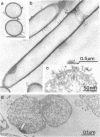Abstract
Autolysis was induced to form stable, cell wall-free cells of Clostridium thermohydrosulfuricum JW102 and Thermoanaerobacter ethanolicus JW200, using a complex medium containing glycine (0.4% wt/vol) and/or sucrose or glycerol (10% wt/vol) at an optimum temperature of 64°C. Autoplasts of both bacteria were grown as L-phase colonies on solid medium; more than 50% of these colonies regenerated to the walled form during prolonged incubation. The removal of the cell wall was confirmed by electron microscopy.
Full text
PDF



Images in this article
Selected References
These references are in PubMed. This may not be the complete list of references from this article.
- Fodor K., Alföldi L. Fusion of protoplasts of Bacillus megaterium. Proc Natl Acad Sci U S A. 1976 Jun;73(6):2147–2150. doi: 10.1073/pnas.73.6.2147. [DOI] [PMC free article] [PubMed] [Google Scholar]
- Hollaus F., Sleytr U. On the taxonomy and fine structure of some hyperthermophilic saccharolytic Clostridia. Arch Mikrobiol. 1972;86(2):129–146. doi: 10.1007/BF00413368. [DOI] [PubMed] [Google Scholar]
- KELLENBERGER E., RYTER A., SECHAUD J. Electron microscope study of DNA-containing plasms. II. Vegetative and mature phage DNA as compared with normal bacterial nucleoids in different physiological states. J Biophys Biochem Cytol. 1958 Nov 25;4(6):671–678. doi: 10.1083/jcb.4.6.671. [DOI] [PMC free article] [PubMed] [Google Scholar]
- Knowlton S., Ferchak J. D., Alexander J. K. Protoplast Regeneration in Clostridium tertium: Isolation of Derivatives with High-Frequency Regeneration. Appl Environ Microbiol. 1984 Dec;48(6):1246–1247. doi: 10.1128/aem.48.6.1246-1247.1984. [DOI] [PMC free article] [PubMed] [Google Scholar]
- LUFT J. H. Improvements in epoxy resin embedding methods. J Biophys Biochem Cytol. 1961 Feb;9:409–414. doi: 10.1083/jcb.9.2.409. [DOI] [PMC free article] [PubMed] [Google Scholar]
- Landman O. E., Forman A. Gelatin-induced reversion of protoplasts of Bacillus subtilis to the bacillary form: biosynthesis of macromolecules and wall during successive steps. J Bacteriol. 1969 Aug;99(2):576–589. doi: 10.1128/jb.99.2.576-589.1969. [DOI] [PMC free article] [PubMed] [Google Scholar]
- Luft J. H. Ruthenium red and violet. I. Chemistry, purification, methods of use for electron microscopy and mechanism of action. Anat Rec. 1971 Nov;171(3):347–368. doi: 10.1002/ar.1091710302. [DOI] [PubMed] [Google Scholar]
- Mercenier A., Chassy B. M. Strategies for the development of bacterial transformation systems. Biochimie. 1988 Apr;70(4):503–517. doi: 10.1016/0300-9084(88)90086-7. [DOI] [PubMed] [Google Scholar]
- Schaeffer P., Cami B., Hotchkiss R. D. Fusion of bacterial protoplasts. Proc Natl Acad Sci U S A. 1976 Jun;73(6):2151–2155. doi: 10.1073/pnas.73.6.2151. [DOI] [PMC free article] [PubMed] [Google Scholar]
- Sleytr U. B., Glauert A. M. Ultrastructure of the cell walls of two closely related clostridia that possess different regular arrays of surface subunits. J Bacteriol. 1976 May;126(2):869–882. doi: 10.1128/jb.126.2.869-882.1976. [DOI] [PMC free article] [PubMed] [Google Scholar]
- Stal M. H., Blaschek H. P. Protoplast formation and cell wall regeneration in Clostridium perfringens. Appl Environ Microbiol. 1985 Oct;50(4):1097–1099. doi: 10.1128/aem.50.4.1097-1099.1985. [DOI] [PMC free article] [PubMed] [Google Scholar]
- Wiegel J., Ljungdahl L. G., Rawson J. R. Isolation from soil and properties of the extreme thermophile Clostridium thermohydrosulfuricum. J Bacteriol. 1979 Sep;139(3):800–810. doi: 10.1128/jb.139.3.800-810.1979. [DOI] [PMC free article] [PubMed] [Google Scholar]




